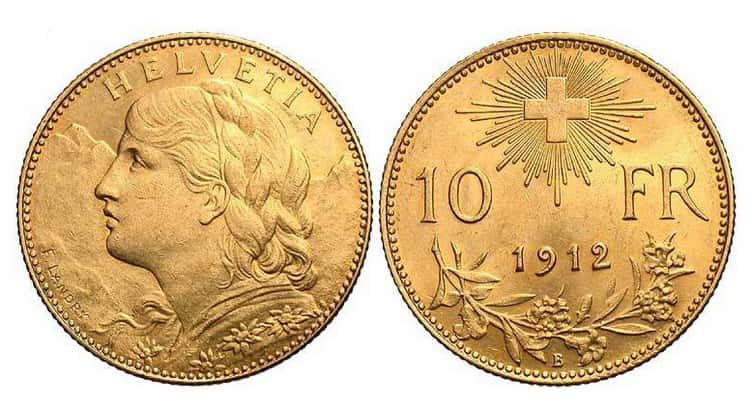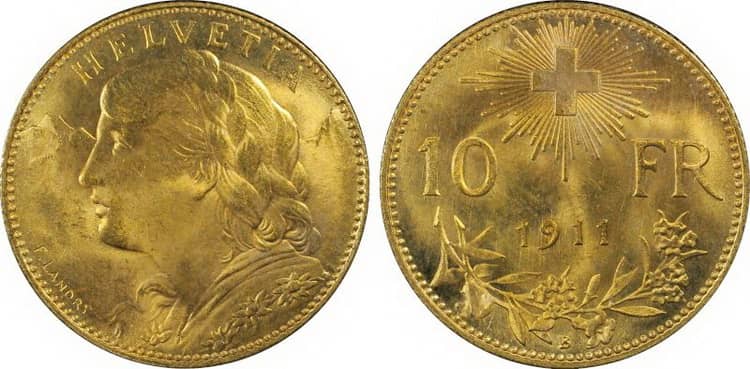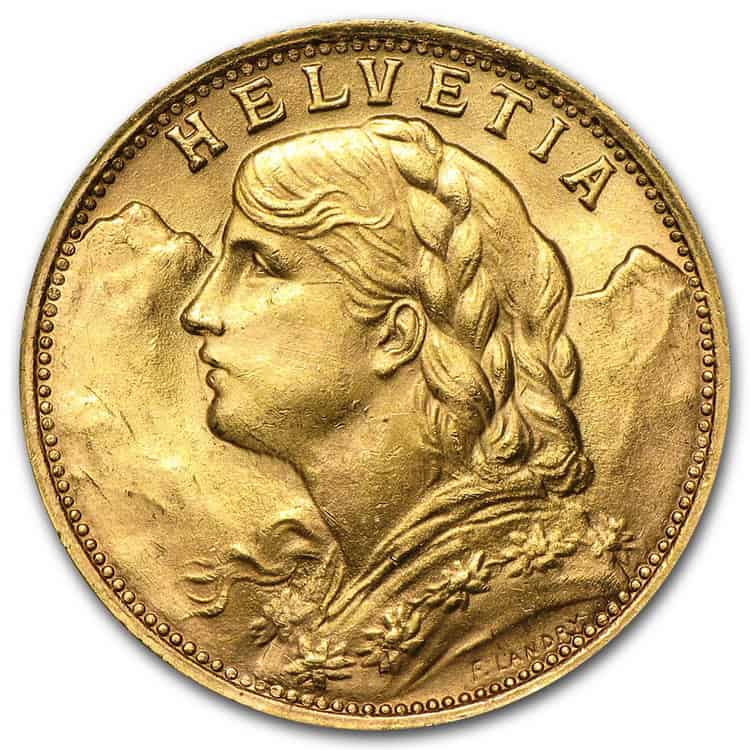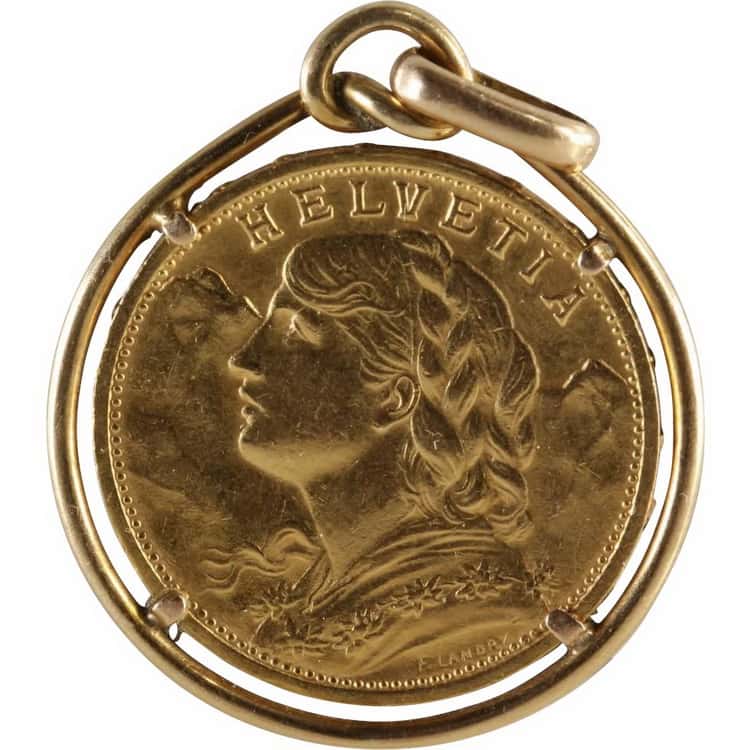
10 Swiss francs (1911–1922) are extremely popular among collectors. With the advent of this series of gold coins, a whole series of events are connected, such as the appointment of the Swiss single currency and the First World War. A lot of stories are associated with the design of the first edition. Thanks to these features, the cost of a modern coin is significantly higher than the gold it contains. All 10 Francs Swiss gold coins in our catalog.
History
The Swiss franc is a cult coin of Europe, personifying the rich history and culture of the country. Since its inception, the small territory consisted of a variety of nationalities and was a complex confederation in structure. Each nation had its own canton, federal district and region. Each region had its own money in use, which was accepted in other cities. Also in circulation was a foreign currency, which brought merchants from different countries. In total, there were about 8,000 types of money in use, which made the monetary system very difficult.

Money was minted in more than 75 institutions located in 25 cantons, 16 cities and abbeys. At that time, there were approximately 860 types of coins in Switzerland. Institutions issued coins that differed in denomination, weight, and assessed value. The presence of the first banknotes further complicated the trade relations between the cantons. The government faced the task of coming to a single currency. For this purpose, the franc was chosen (the name of the monetary unit was borrowed from France). The only institution issuing money in Switzerland was the Federal Government.
Did you know? In fact, the name “Frank” comes from the Latin expression “Francorum Rex”, which means “King of the Franks”. This phrase was found on old French coins. The currency code of the Swiss franc “CHF” means “Confoederatio Helvetica Franc”. Swiss money is also called Stutz, Stei, Amiese, Frankler, Liber.
At first, the Swiss monetary policy was based on the conditions of the Latin Monetary Union (France, Belgium, Italy, Switzerland). The single exchange rate was regulated in the international arena and a weighted assessment of cash within countries. States came to the single rule that 0.2903 gold equates to 4.5 grams of silver. Even after the union collapsed in 1924, Switzerland continued to adhere to this ratio until 1967.

According to the regulations, the Swiss Mint in Bern began the production of iconic coins:
- 100 Swiss francs (1917-1967)
- 20 Swiss francs (1897–1949)
- 10 Swiss francs (1911–1922)
Did you know? The Swiss 10 francs of 1911–1922 were the official currency not only in their own country, but also in Liechtenstein, in an Italian town called Campione d’Italia (Como Province, Lombardy Region) and in the German city of Bissingen (a commune in Germany, in the land of Bavaria).
The gold coin of 10 Swiss francs of 1911-1922 belongs to the series known as “Vreneli” from the word “Verena”. The series received the status of a legal tender issued by Switzerland. Another name for coins, popular among the numismatists, is “Swiss Miss”, or “Helvetia”, also derived from the portrait depicted on the obverse. You can find all 100 Francs and 20 Francs Swiss gold coins in our catalog.
Design
Around 500 BC, a Celtic tribe settled in Switzerland, whose people called themselves the Helvets. By the name of the tribe, these lands began to be called “Helvetia”. Later, the country received its modern name, and Helvetia was portrayed as an allegorical female figure, a national symbol of the country. The female image personifies the Swiss Confederation (Confoederatio Helvetica). The model for Fresnel was chosen by Françoise Engli.
Characteristics of 10 Swiss francs 1911-1922

- Material: gold.
- Composition: 900/1000.
- Weight: 3,226 grams.
- Net weight: 2,903 grams.
- Diameter: 18.5 mm.
- Thickness: 0.90 mm.
- Obverse: On the obverse of 10 Swiss francs, Vreneli is depicted as a young maiden with braided hair. The Swiss Alps are engraved in the background. The neck of the girl is decorated with a wreath of flowers. The only inscription present on the obverse is HELVETIA, as well as the signature of the master engraver F. Landry.
- Did you know? From 1897 to 1936, and also from 1947 to 1949, approximately 61,000,000 gold coins were minted with the common name “Vreneli”. The most common instance is the Swiss 20 francs of 1897-1949. Despite the fact that the coin received the investment status, it also occupied a prestigious place in numismatic circles.
- Reverse: In the upper side of the reverse of the gold coin there is the national emblem of Switzerland − a cross in the sun. Below to the left there is the denomination of the coin in the form of the number “10” and the abbreviated name of the currency FR (franc). The lower part is decorated with thin sprigs of alpine flowers. Below them the letter “B” is placed as a symbol that the coin was minted in Bern.
Did you know? In 1895, the Federal Government announced a competition for the best image of Helvetia for the obverse of the future coin. Fritz Landry (Fritz Ulysse Landry) created more modern portrait, but most of the commission members did not like it. According to the general opinion, the same spirit of the Motherland was missing in the image. The well-known numismatist Imhof Blumer stood up for the engraver and convinced the commission that the portrait corresponds to the modern and progressive future of the country.
Some members of the commission suggested that modern Switzerland is not comparable to a young woman. Instead, Helvetia should have looked like a beautiful adult woman or mother. Others opposed the mountains in the background, as the modern industrial nation must break free from its outdated comparison with mountains and shepherds. Still others wanted to see the image of William Tell − the legendary folk hero of Switzerland.
Did you know? The first trial batch of “progressive” 10 Swiss francs was minted in an amount of 100 pieces. Representatives of the Berne Magistrate refused to accept this print run, since the homeland was present unkempt curl on his forehead. The artist had to redo the image of a young maiden again, and the new coins with a cropped curl are popularly called “sheared”. But this “Swiss Miss” design is considered the most attractive of all the issues of coins. Despite the fact that the officials found the strand on young Helvetia’s forehead too frivolous, the Swiss 10 and 20 francs with this image are highly valued among the coin collectors. In January of 2013, at the auction one of these “Stirnlenenvrenelis” was sold for more than 100,000 francs.
Circulation
The 10 Swiss francs of 1911–1922 are distinguished by the smallest period of coinage. In some years, gold coins were not produced. In 12 years, a total of 2,600,000 samples were produced. All Swiss gold coins in our catalog.
Circulation of 10 Swiss francs (1911-1922):
- 1911 − 100,000 pcs .
- 1912 − 200,000 pcs.
- 1913 − 600,000 pcs .
- 1914 − 200,000 pcs .
- 1915 − 400,000 pcs .
- 1916 − 130,000 pcs .
- 1922 − 1,020,000 pcs ..
Cost of coins
The price of 10 Swiss francs (1911-1922) of gold depends on the degree of preservation and the year of release:
- 1911 as a VF −150 $ USD
- 1912 as a VF −155 $ USD
- 1913 as an EF – 180 $ USD
- 1915 as Almost Uncirculated – 90 $ USD
- 1922 in good condition − from 180 $ USD
Comments
No commens yet.